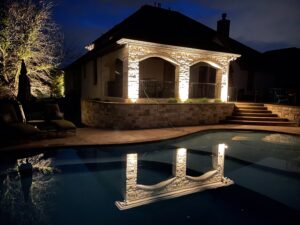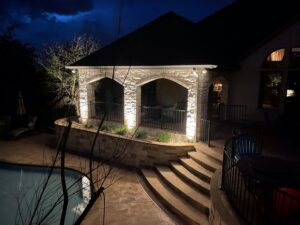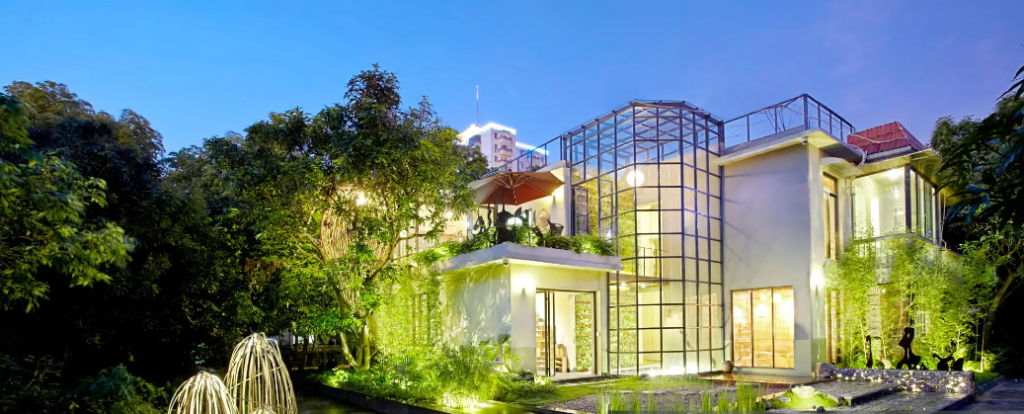Landscape lighting is a transformative element that can elevate the beauty and functionality of any property. By strategically illuminating your outdoor spaces, you create a welcoming glow that enhances curb appeal, improves safety, and extends the usability of your outdoor areas well into the evening hours. The soft illumination of well-placed light fixtures can turn an ordinary yard into a magical nighttime retreat, highlighting the best features of your landscape and creating an inviting atmosphere for both family and guests.
In this comprehensive guide, we’ll explore the world of landscape lighting, and its numerous benefits, and provide you with easy-to-follow steps for installation. Whether you’re considering a do-it-yourself installation or contemplating professional help, this article will equip you with the knowledge to make informed decisions about your outdoor lighting project. From understanding the basics of low-voltage lighting systems to troubleshooting common issues, we’ll cover everything you need to know to bring your outdoor lighting vision to life.
What is Landscape Lighting?

Landscape lighting, also known as outdoor lighting, refers to the use of illumination to highlight and enhance the exterior features of a property. This type of lighting goes beyond mere functionality, serving as a powerful tool to create ambiance, improve security, and showcase the beauty of your home and garden after dark. A well-designed landscape lighting system can transform your outdoor space, creating depth, texture, and drama that simply isn’t visible during daylight hours.
Low Voltage Landscape Lighting
Low-voltage landscape lighting systems are the most common choice for residential properties. These systems typically consist of three main components:
- A transformer that steps down the standard 120-volt household current to a safer 12-volt
- A low-voltage cable that distributes power to the light fixtures
- A variety of light fixtures designed for different purposes such as path lighting, flood lights, and accent lighting
The transformer is the heart of the system, converting high-voltage electricity into a safer, more energy-efficient low-voltage current. This low-voltage electrical cable then runs throughout your yard, connecting to various light fixtures. These fixtures come in a wide range of styles and functionalities, from subtle path lights that guide your way to powerful floodlights that illuminate large areas.
By carefully selecting and positioning these elements, homeowners can craft a captivating nighttime landscape that combines safety, aesthetics, and energy efficiency. The versatility of landscape lighting allows for endless creativity, enabling you to highlight architectural features, illuminate garden paths, create moonlighting effects through trees, or even showcase water features with submersible lights.
The Benefits of Landscape Lighting

Implementing a well-designed landscape lighting system offers numerous advantages for homeowners. Let’s explore some of the key benefits that make outdoor lighting a worthwhile investment:
Enhanced Curb Appeal
A thoughtfully illuminated exterior dramatically improves your home’s appearance after dark. By highlighting architectural features, trees, and garden elements, landscape lighting creates a visually appealing nighttime scene that can significantly boost your property’s curb appeal. The soft glow of strategically placed lights can accentuate the textures of your home’s facade, create dramatic shadows, and draw attention to prized landscaping features, making your property stand out in the neighborhood.
Increased Safety and Security
Proper outdoor lighting helps prevent accidents by illuminating potential hazards like steps, uneven surfaces, and obstructions. Path lighting along walkways and driveways ensure safe navigation, while flood lights can eliminate dark corners where someone might trip or fall. Additionally, a well-lit property deters intruders, making your home less vulnerable to break-ins and vandalism. Motion-activated security lights can startle potential intruders and alert you to any unusual activity around your property.
Extended Outdoor Living
Landscape lighting extends the usability of your outdoor areas well beyond sunset, allowing you to make the most of your exterior spaces regardless of the time of day. Illuminate patios, decks, and gardens to create inviting areas for relaxation and entertainment, effectively expanding your living space. Soft lighting around seating areas creates a cozy atmosphere for evening gatherings, while subtle illumination in garden beds allows you to appreciate your landscaping even at night. This extended use of your outdoor areas can significantly enhance your quality of life, especially during seasons with shorter daylight hours.
Energy Efficiency
Modern landscape lighting systems, especially those using LED lights, are highly energy-efficient. Low-voltage lighting consumes less power than traditional high-voltage systems, helping to reduce electricity costs while minimizing environmental impact. LED bulbs, in particular, use a fraction of the energy of incandescent bulbs and last much longer, reducing both energy consumption and maintenance needs. Many systems also incorporate timers or smart controls, allowing you to program lights to turn on and off automatically, further optimizing energy use.
Versatility and Customization
Landscape lighting offers endless possibilities for customization. From subtle path lighting to dramatic focal point illumination, you can tailor your lighting design to suit your personal style and highlight your property’s unique features. Different types of fixtures and bulbs allow you to create various effects, such as silhouetting, grazing, or moonlighting. You can also adjust the intensity and color temperature of the lights to create different moods or to complement specific landscaping elements.
Increased Property Value
A well-executed landscape lighting system can add value to your home. Potential buyers often view outdoor lighting as a desirable feature, potentially increasing your property’s marketability and resale value. The enhanced curb appeal and extended usability of outdoor spaces make your property more attractive to prospective buyers, setting it apart from similar homes without landscape lighting.
The Easiest Way to Install Landscape Lighting: A Step-by-Step Guide

Installing landscape lighting doesn’t have to be a daunting task. With the right approach and tools, you can achieve professional-looking results. Here’s a step-by-step guide to help you through the process:
Plan Your Layout
Before you begin, sketch out your property and decide where you want to place your light fixtures. Consider areas that need illumination for safety, such as pathways and steps, as well as features you’d like to highlight, like trees or architectural elements. Think about the overall effect you want to achieve and how different lighting techniques can help you reach your goals.
Choose Your Fixtures
Select light fixtures that complement your home’s style and serve your intended purposes. Options include path lights, spotlights, flood lights, and accent lights. Ensure that all fixtures are compatible with low-voltage systems. Consider factors such as durability, weather resistance, and ease of maintenance when making your selections. Plastic fixtures may be more affordable but might not last as long as metal ones in harsh weather conditions.
Calculate Power Requirements
Determine the total wattage of all the fixtures you plan to install. This will help you choose the right transformer capacity. As a rule of thumb, your transformer should be rated for about 20% more than your total fixture wattage to account for the voltage drop along the cable length. This ensures that even the fixtures furthest from the transformer receive adequate power.
Install the Transformer
Mount the transformer near an outdoor electrical outlet, following the manufacturer’s instructions. Most transformers can be mounted directly to the exterior wall of your home. Ensure it’s protected from the elements while in use. Some homeowners choose to install the transformer in a weatherproof box or under an eave for additional protection.
Lay Out the Low Voltage Cable
Starting from the transformer, lay out the low-voltage landscape lighting wire along your planned lighting path. Use a flat-blade shovel to create a narrow trench for the cable, or simply tuck it under the sod. If you’re working in an area with a lot of plantings, you might consider using a garden hose to mark the path of your cable before digging.
Connect Fixtures to the Cable
At each fixture point, strip the rubber insulation from the low-voltage wire using wire strippers. Connect the fixture’s lead wires to the main cable using waterproof wire connectors. Many systems use simple push-in or snap-on connectors that don’t require special tools. Ensure that the wire connections are secure and protected from moisture to prevent electrical issues down the line.
Install the Light Fixtures
Position each light fixture according to your plan. Most landscape lights come with a metal ground stake or can be mounted on surfaces like concrete walkways. Ensure each fixture is securely installed and positioned correctly. For areas with soft soil, you might need to use a long steel punch to create a pilot hole for the fixture’s stake.
Connect the Transformer
Once all fixtures are in place, connect the low-voltage cable to the terminal screws on the transformer. Some systems may require you to connect the first fixture directly to the transformer’s power cord. Double-check all connections to ensure they’re tight and secure.
Test and Adjust
Turn on the system and check that all fixtures are working properly. Adjust the angle and direction of lights as needed to achieve the desired effect. Replace any burned-out bulbs and troubleshoot any fixtures that aren’t lighting up. This is also a good time to assess the overall lighting effect and make any necessary adjustments to fixture placement or bulb intensity.
Conceal the Cable
Once you’re satisfied with the lighting setup, bury the low-voltage cable. You can use a long steel punch to create a slit in the soil and push the cable down, or cover it with mulch in planting beds. In areas where burying isn’t possible, consider using a PVC pipe or other conduit to protect and conceal the cable.
Fine-tune and Maintain
Over the next few days, observe your lighting system at different times to ensure it’s performing as desired. Make any final adjustments to fixture positions or bulb types as needed. Regularly check your system for any signs of damage or wear, and promptly replace any faulty components to keep your landscape lighting looking its best.
Professional Landscape Lighting Installers Vs. DIY

When it comes to installing landscape lighting, homeowners often debate whether to tackle the project themselves or hire a professional. Let’s examine the pros and cons of each approach:
DIY Installation Pros
- Cost savings on labor
- Personal satisfaction of completing the project
- Flexibility to work at your own pace
- Ability to make changes and adjustments easily
DIY Installation Cons
- Time-consuming for inexperienced installers
- Potential for mistakes or suboptimal design
- Limited access to professional-grade equipment and fixtures
- Risk of improper electrical connections
- Possible voiding of warranties if not installed correctly
Professional Installation Pros
- Expert design and placement for optimal effect
- Access to high-quality, professional-grade fixtures
- Efficient installation with proper tools and techniques
- Guaranteed safety and code compliance
- Warranty on workmanship and often on fixtures
- Knowledge of advanced techniques like moonlighting and silhouetting
Professional Installation Cons
- Higher upfront cost compared to DIY
- Reliance on the contractor’s schedule
- Less hands-on involvement in the process
While DIY installation can be rewarding, going pro offers significant advantages. Professional installers bring expertise in design, technical knowledge of electrical systems, and access to superior products. They can create a cohesive lighting plan that maximizes the beauty and functionality of your outdoor spaces while ensuring safety and longevity.
Professionals understand the intricacies of voltage drop and how to design a system that maintains consistent brightness across all fixtures. They’re also familiar with local codes and regulations, ensuring your installation is compliant and safe. For complex systems or those seeking the best possible results, professional installation is often the superior choice.
Get Professional Help from Plano Outdoor Lighting Co.
At Plano Outdoor Lighting Co., we pride ourselves on being the premier outdoor lighting specialists in the Plano, TX area. Our team of expert designers and installers brings years of experience and a passion for creating stunning landscape lighting solutions tailored to each client’s unique needs and preferences.
When you choose Plano Outdoor Lighting Co., you’re not just getting a lighting installer – you’re partnering with a company that understands the art and science of outdoor illumination. We take the time to understand your vision, assess your property’s unique features, and design a lighting system that enhances your home’s beauty while addressing practical concerns like safety and energy efficiency.
Our comprehensive services include:
- Custom lighting design that considers your home’s architecture and landscaping
- High-quality, durable fixtures from top manufacturers
- Expert installation by licensed professionals
- Energy-efficient LED solutions that reduce your carbon footprint and energy bills
- Ongoing maintenance and support to keep your system looking its best
We understand that every property is unique, and we approach each project with fresh eyes and creative solutions. Whether you’re looking to illuminate a small garden or create a comprehensive lighting scheme for a large estate, our team has the skills and experience to bring your vision to life.
Don’t settle for a one-size-fits-all approach or risk the pitfalls of a DIY installation. Let our team transform your outdoor spaces into a breathtaking nighttime oasis. Contact Plano Outdoor Lighting Co. today for a free consultation and experience the difference that professional landscape lighting can make for your home.
In Summary
Landscape lighting is a powerful tool for enhancing the beauty, safety, and functionality of your outdoor spaces. From improving curb appeal to extending your living areas, the benefits of a well-designed outdoor lighting system are numerous. While DIY installation is possible for those with the time and inclination, professional installation offers significant advantages in terms of design expertise, quality of components, and long-term performance.
Whether you choose to tackle the project yourself or enlist the help of professionals like Plano Outdoor Lighting Co., investing in landscape lighting is a decision that will pay dividends in enjoyment and property value for years to come. Illuminate your outdoor world and discover the transformative power of landscape lighting today.

